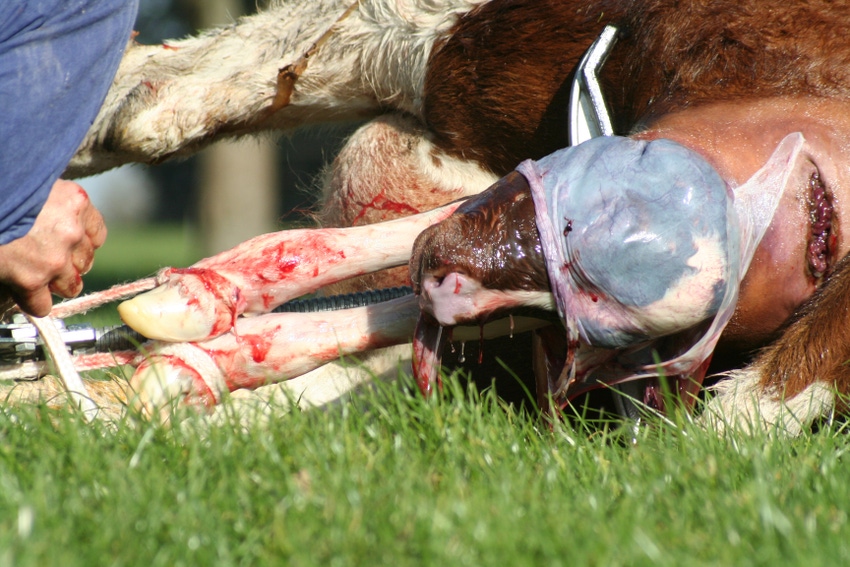Effect of calving difficulty on reproductive performance
Dystocia can cause major economic impacts in operations.
September 11, 2023

Dr. Saulo Zoca, University of Tennessee Institute of Agriculture
Fall calving season is upon us, and what happens during this time can affect our breeding season results. Dystocia is the proper name given to when there are any problems during birth, i.e. calving. It can be associated with a plethora of reasons such as a calf that is larger than the birth canal or a calf that is not in the correct position for calving. Age of the dam, calf sex and birth weight are a few other things that are associated with the incidence of dystocia. With that, heifers have a greater chance than mature cows to have dystocia. Male and heavier calves have a greater chance of causing calving difficulty than female and lighter calves. Thus, a mature cow carrying a light heifer has less chance of having calving problem than a heifer carrying a heavy bull calf.
Dystocia can cause major economic impacts in operations. The first and more noticeable is the loss of a calf; however, it can have long lasting effects to the dam’s reproductive efficiency. It is very common for a cow that has experienced calving difficulty to display certain diseases, such as retention of fetal membranes (retained placenta) that might cause uterine infection (pyometra). This can predispose cows to ovarian dysfunction and subsequent reduced fertility. Further, dystocia can be a silent villain because of its effect on postpartum anestrus.
Anestrus is the period when cows and heifers are not cycling, meaning that there is no ovarian activity thus, no estrus. In heifers, anestrus is naturally occurring on pre-pubertal animals and ceases when they become pubertal and have regular estrus interval. In cows, it naturally occurs after calving, and its length is variable based on age, presence of calf (milking events), nutritional status, and calving event (dystocia). The postpartum anestrus can range from 14 to 180 days; in mature cows, an interval of 30 to 90 days to return to cyclicity is considered normal while in young cows (2-year-old), an interval of up to 120 days is also considered normal. Management of the postpartum anestrus is already a hard but when a cow experiences dystocia, it has the potential to make anestrus even longer.
Research investigating the impact of dystocia on postpartum interval and conception rates indicates that as incidence of dystocia increased, the time needed for uterine involution and the postpartum anestrus also increased. Thus, the number of females that had resumed cyclicity by the beginning of the breeding season were smaller, and consequently, there were less females pregnant by artificial insemination at the end of the breeding season.
Any time a cow goes through prolonged calving, her reproductive performance and the calf health can be compromised. Nevertheless, some obstetric actions can be taken to mitigate the impact of dystocia. The average duration of parturition has been reported to be 54 minutes for heifers (first time calving) and 22 minutes for cows. In the same report, a bull calf delivery took on average 8 minutes longer than a heifer calf. Research results have reported that the use of early obstetrical assistance given when the reproductive tract (cervix) was fully dilated reduced the negative effects associated with postpartum reproductive problems; also, calf performance was not affected when proper obstetrical assistance was performed. Furthermore, for every 30 minutes delay in assistance after 1.5 hours of stage II labor (first appearance of the water bag until calf is delivered) resulted in a 6 day longer interval to pregnancy on the following estrous cycle.
To mitigate the effects of dystocia on the following breeding season, proactively checking cows (and heifers) this upcoming fall calving season allows producers to intervene as early as possible WHEN NECESSARY. One of the best practice management strategies to reduce the incidence of dystocia is selecting sires proven to be easy calving, especially with smaller cows and young heifers. So, as calving season gets into full swing, it is important to remember the impacts calving season can have on the upcoming breeding season. When dystocia does occur, proper intervention will help reduce reproductive problems during the following breeding season. However, planning ahead to prevent dystocia is of equal importance.
Hopefully dystocia is not a major concern on your operation, but if it is, these tools should allow you to proactively deal with the situation, thus decreasing the negative effects it can have on the upcoming breeding season.
You May Also Like


.png?width=300&auto=webp&quality=80&disable=upscale)
